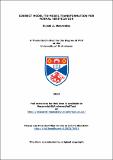Files in this item
Correct model-to-model transformation for formal verification
Item metadata
| dc.contributor.advisor | Bowles, Juliana | |
| dc.contributor.advisor | Balasubramaniam, Dharini | |
| dc.contributor.author | Meedeniya, Dulani Apeksha | |
| dc.coverage.spatial | 420 | en_US |
| dc.date.accessioned | 2013-06-13T11:15:41Z | |
| dc.date.available | 2013-06-13T11:15:41Z | |
| dc.date.issued | 2013-06-26 | |
| dc.identifier | uk.bl.ethos.574798 | |
| dc.identifier.uri | https://hdl.handle.net/10023/3691 | |
| dc.description.abstract | Modern software systems have increasingly higher expectations on their reliability, in particular if the systems are critical and real-time. The development of these complex software systems requires strong modelling and analysis methods including quantitative modelling and formal verification. Unified Modelling Language (UML) is a widely used and intuitive graphical modelling language to design complex systems, while formal models provide a theoretical support to verify system design models. However, UML models are not sufficient to guarantee correct system designs and formal models, on the other hand, are often restrictive and complex to use. It is believed that a combined approach comprising the advantages of both models can offer better designs for modern complex software development needs. This thesis focuses on the design and development of a rigorous framework based on Model Driven Development (MDD) that facilitates transformations of non-formal models into formal models for design verification. This thesis defines and describes the transformation from UML2 sequence diagrams to coloured Petri nets and proves syntactic and semantic correctness of the transformation. Additionally, we explore ways of adding information (time, probability, and hierarchy) to a design and how it can be added onto extensions of a target model. Correctness results are extended in this context. The approach in this thesis is novel and significant both in how to establish semantic and syntactic correctness of transformations, and how to explore semantic variability in the target model for formal analysis. Hence, the motivation of this thesis establishes: the UML behavioural models can be validated by correct transformation of them into formal models that can be formally analysed and verified. | en_US |
| dc.language.iso | en | en_US |
| dc.publisher | University of St Andrews | |
| dc.subject | Model transformation | en_US |
| dc.subject | Semantic and syntactic correctness | en_US |
| dc.subject | UML diagram | en_US |
| dc.subject | Coloured petri net | en_US |
| dc.subject.lcc | QA76.9C65M4 | |
| dc.subject.lcsh | Computer simulation | en_US |
| dc.subject.lcsh | UML (Computer science) | en_US |
| dc.subject.lcsh | Petri nets | en_US |
| dc.subject.lcsh | Computer software--Verification | en_US |
| dc.subject.lcsh | Computer programs--Correctness | en_US |
| dc.subject.lcsh | Transformations (Mathematics) | en_US |
| dc.title | Correct model-to-model transformation for formal verification | en_US |
| dc.type | Thesis | en_US |
| dc.contributor.sponsor | Scottish Informatics and Computer Science Alliance (SICSA) | en_US |
| dc.type.qualificationlevel | Doctoral | en_US |
| dc.type.qualificationname | PhD Doctor of Philosophy | en_US |
| dc.publisher.institution | The University of St Andrews | en_US |
This item appears in the following Collection(s)
Items in the St Andrews Research Repository are protected by copyright, with all rights reserved, unless otherwise indicated.

